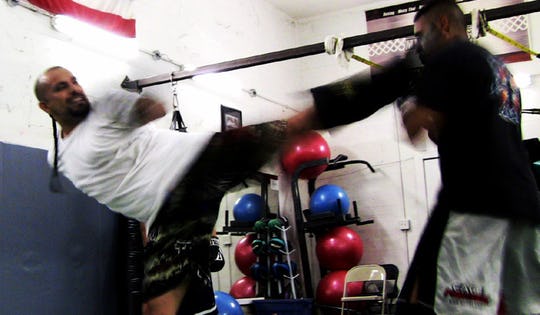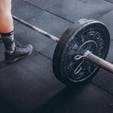An often neglected aspect of training, hip strength can make or break your martial arts practice and limit your lower body strength development. Tom Furman walks you through a simple workout regimen to get you going in the right direction.
The delicate balance between speed and strength, stability and mobility, endurance and power, is visibly evident in Mixed Martial Arts fighting. The hip joint of bthe fighter takes a tremendous pounding, not only from the punishment of the match, but in the hours of sparring needed to develop world class skills.
The hip itself is surrounded by some of the most powerful muscles in the body. In the rear you have the gluteal group, in the front, the hip flexors, on the outside the abductors, and on the inner thigh, the adductor group. There are many possible variations in movement, but this 4-way division of function will allow us to exploit a training program devoid of fluff and focusing on old school hard work. The beginning, middle, and end of any hip work is the squat. Therefore, you get only one guess as to how we start our workout:
Hip Strength For MMA Workout A
1.) The Box Squat
The Box Squat is first on the menu. If you don’t have a power rack and a box and a barbell, get one. You can substitute “garage adaptations” of picnic benches, sandbags, and cement blocks, but good equipment will pay dividends and improve safety and efficiency.
The exercise is self explanatory. Simple load the barbell, sit back and relax the quads, then lean forward, keeping everything tight, and stand up. Flex the quads, the glutes, and all surrounding hip muscles for a count. Repeat this process in sets of 3 reps. Descend slowly, but stand up with a forceful action. This exercise will be alternated with the next one.
2.) Hanging Knee Raises
Hanging Knee Raises will provide a much needed stretch, and also activate the hip flexors on the front of the hip. Hang from an overhead bar, allow the body to go perfectly straight. Pull the knees to the chest in one count, pause for a count, and lower slowly to a three count. Once again do just three repetitions. Rest one minute and move back to squats.
These two exercises constitute Workout A. They should be preceded by a light warm up, and followed by sustained static stretching. Simply wait out the tension and hold the finished or maximum position to enhance re-modelling the plastic element of the involved connective tissue. Good form is essential.
Hip Strength For MMA Workout B
Once again, warm up using those mobility drills that allow you remove kinks, get you sweating, and psychologically ready for hard work.
1.) Lateral Limbo Lunge
The Lateral Limbo Lunge is an exercise developed by Coach John Davies (although this movement was 2probably performed by trainees in gymnasiums for years). You will need a type of limbo pole, string, band, or rope that is fixed below shoulder height. It’s best to be conservative at first so your flexibility can adapt slowly while you maintain perfect form. Grab a dumbbell or kettlebell or even a barbell plate. Stand beside the limbo apparatus with the weight in your hands at your hips.
Endeavor to keep an upright posture and duck below the limbo pole moving laterally. You will be stepping out to the side, assuming a squat position, and smoothly moving underneath the pole to the other side and bringing your feet back together. It will be essentially a side step with a reduction of height by bending at the hips and knees. You will feel tremendous stretching in and around the hips. Not much resistance is needed. You will do ten repetitions in each direction, both left and right.
2.) Hip Bridging
This is the second exercise of this super set. You will need to pad a lightly loaded barbell. Position it over the hips, right at the crease. The low back or lumbar region should never, ever be hyper extended. The feet should be close to the butt, but not excessively so. I think a slightly padded surface is best for comfort. Now bridge the hips with all movement coming from the contraction of the glutes. At the top of the motion you should feel some stretching in the hip flexors which is a good sign that you are activating your hips and not extending your lower back. Repeat for 10 repetitions. Rest a minute and move back to Lateral Limbo Lunge for 3 total super sets.
3.) Goblet Squats
You will be doing 10 repetitions again. A dumbbell or kettlebell can be used. It is held at chest height, like a goblet, and you squat as deep as possible using the lighter weight as a counter balance, and position the elbows for leverage against the knees to increase the stretch of the deep inner thigh muscles. This is hip mobility at its best and you need to hold the bottom position for 3 long counts for full effect. Move immediately to the next exercise.
4.) Guard Sit Ups
Use of the sit up is highly controversial. It is part of many fitness tests for special response teams. Dr. McGill in Canada says it puts tremendous force on the spine. As a MMA fighter, it is part of life. You must build up to this drill since you will be spending much of your time in this position.
Start with a heavy bag on the floor, but make sure it is braced by a training partner. In time, you will suspend it off of the ground for a truly dynamic hip and abdominal training drill. For now wrap your legs around the bag and lock your ankles. Pick a spot high on the bag and try sitting up to touch it. Pinch strongly with your thighs as your torso contracts. This will increase strength and protect your back. Ten repetitions is your goal. If you can only do one or two, that is fine. You will progress with adequate training and rest. Rest for one minute then repeat the Goblet Squat/Guard Sit Up Super Set 3 times with a minute rest in between each cycle.
Take two minutes to rest and shake out your limbs. Then move on to Partner Assisted Isometric Stretching. If you have no partner, you may use a routine of resistive stretching with Jumpstretch Bands. However, having a trusted training partner helping you with Partner Assisted Isometric style of stretching will insure gains in both flexibility and joint strength.
It is beyond the scope of this article to demonstrate or explain the theory of facilitated isometric stretching. For best results, I highly recommend six second incremental holds, and a final hold of thirty seconds for all involved muscle groups.
For aerobic/anaerobic outdoor training, I would highly recommend hill running with breaks consisting of Up Dog/Down Dog drills from Yoga. Then follow the session with your favorite relaxed stretching methods.
Workout Recommendations
The cycle I recommend is Day one, Workout A. Day two off from conditioning, Day three, aerobic/anaerobic training, Day four off, Day five, Workout B. Then two days off. That would be Monday through Friday. Take the weekend off, then on Monday, start with the Aerobic/Anaerobic Training, and follow the same pattern. Focus on small, constant improvement week to week. If a competition is planned, reduce the frequency of the conditioning to two times per week and focus fully on fighting skills. After all, you are training to fight, not training to train.
MMA is martial arts in the extreme and training must not be unplanned and unproductive. It has to be progressive and planned.
Train Hard.

)





